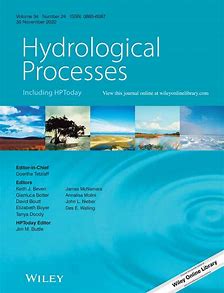- Department:(Dept. 1) Ecohydrology and Biogeochemistry
Quantifying changes and trends of NO3 concentrations and concentration-discharge relationships in a complex, heavily managed, drought-sensitive river system
Long-term stream nitrate nitrogen concentrations and concentration-discharge were investigated along the Spree revealing significant heterogeneity in both variables. The upstream parts and winter seasons showed the most serious pollution. Concentrations and relationships are also likely to respond strongly to future droughts, leading to challenges for future land and water management.
Particle-associated organic contaminant and cytotoxicity transport in a river during storm events
This study investigated the mobilisation and transport of particle-associated organic contaminants and their cytotoxicity in a river during storm events. Cytotoxicity determined in cell-based bioassays correlated linearly with total suspended solids concentration in a river, demonstrating that particle-associated contaminant mixtures can strongly affect river water quality during rain events.
Moving Bedforms Control CO2 Production and Distribution in Sandy River Sediments
The study investigated the impact of streamwater flow velocities and the resulting bedform migration on the CO2 production in streambeds. State-of-the-art 2-dimensional imaging techniques reveal the CO2 distribution in the streambed, an increasing CO2 production in the upper sediment and a decreasing hydrological exchange with deeper sediment layers, with increasing flow velocities.
Oxygen depletion and sediment respiration in ice-covered arctic lakes
The study investigated the oxygen budget of 4 arctic lakes using high-frequency data. Incubation experiments measured sediment metabolism. Volume-averaged oxygen depletion in situ was independent of water temperature and duration of ice-cover. Modeling under ice-oxygen dynamics requires consideration of optical properties, biological and transport processes modifying oxygen.
Tracer-aided ecohydrological modelling across climate, landcover, and topographical gradients in the tropics
This study applied a tracer-aided ecohydrology model in a data-scarce tropical catchment, using the output of climate models to estimate spatio-temporal dynamics of how water is partitioned, stored and transported at larger spatial scales. This provided a basis for projecting future climate and vegetation changes and the impact on regional hydrological and biogeochemical cycles.
The unexpected long period of elevated CH4 emissions from an inundated fen meadow ended only with the occurrence of cattail (Typha latifolia)
The authors present 14 years of CH4 flux measurements following rewetting of a formerly long-term drained peatland. During the study, significant differences in CH4 emissions occurred. These differences overlapped with stages of ecosystem transition from a cultivated grassland to a polytrophic lake dominated by emergent helophytes, but could also be additionally explained by other variables.
Integrated ecohydrological hydrometric and stable water isotope data of a drought-sensitive mixed land use lowland catchment
The authors provide open access to a unique ecohydrological and water stable isotope data set from different landscape compartments monitored during the extreme drought of 2018 at multiple spatial scales from lowland headwaters, which are often understudied despite them providing important ecosystem services.This data set allows to differentiate “blue” and “green” water fluxes.
Anaerobic duration predicts biogeochemical consequences of oxygen depletion in lakes
A team from TU Bergakademie Freiberg and IGB has developed an easy-to-use method to estimate the consequences of oxygen depletion in the deep water of lakes. Monitoring data from L. Arendsee and L. Stechlin, a.o., were used to model the spatiotemporal extent of anoxia. The novel tool has the potential to predict the ecological consequences of increasing anoxia in lakes due to climate warming.
Unravelling the role of sulphate in reed development in urban freshwater lakes
The authors analysed data from 14 lakes in the Berlin catchment area for the period 2000 to 2020. They found that if sulphate concentrations had not increased, there would be about 20 per cent more reeds in the sulphate-polluted lakes today.

Worldwide moderate-resolution mapping of lake surface chl-a reveals variable responses to global change (1997–2020)
Whether a lake appears blue or green is also related to its chlorophyll-a content. Researchers led by IGB used satellite data to draw conclusions about the concentrations of the green pigment produced by algae.









